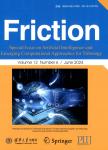Carbon fiber cannot always reduce the wear of PEEK for orthopedic implants under DPPC lubrication
作者机构:Key Laboratory of Advanced Ceramics and Machining Technology of Ministry of EducationTianjin UniversityTianjin 300072China
出 版 物:《Friction》 (摩擦(英文版))
年 卷 期:2023年第11卷第3期
页 面:395-409页
核心收录:
学科分类:08[工学] 080203[工学-机械设计及理论] 0802[工学-机械工程] 0703[理学-化学] 080201[工学-机械制造及其自动化]
基 金:This work was financially supported by the National Natural Science Foundation of China(Grant Nos.52175180,51805366) the Natural Science Foundation of Tianjin City(Grant No.19JCQNJC04100).
主 题:polyetheretherketone(PEEK) carbon fiber-reinforced PEEK(CF-PEEK) dipalmitoylphosphatidylcholine(DPPC) orthopedic implants self-assembly
摘 要:Excellent wear resistance is an important feature of orthopedic implants.However,although pure polyetheretherketone(PEEK)is outperformed by carbon fiber-reinforced PEEK(CF-PEEK)for stability and durability under laboratory conditions,it is not clear whether CF-PEEK should be preferred in all real-world applications.Results indicate that,under dipalmitoylphosphatidylcholine(DPPC)lubrication,the wear rates of PEEK are 35%-80%lower than the wear rates of CF-PEEK for different implant materials,speeds,loadings,and DPPC concentrations.Molecular dynamics calculations confirm that DPPC self-assembles on the PEEK surface to form an easily adsorbed continuous phospholipid lubricating film.In contrast,the carbon fibers on the CF-PEEK surface hinder the formation of the protective DPPC film and the CF-PEEK surface is thus subject to faster wear.



